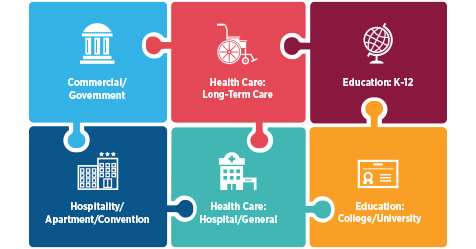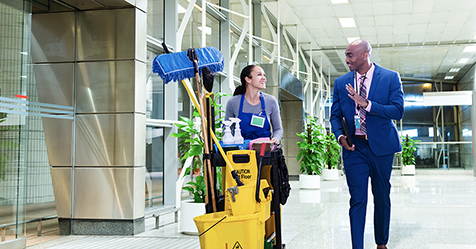On February 14, a gunman walked into Marjory Stoneman Douglass High School in Parkland, FL, killing 14 students and three adults. Not only did this incident bring up conversations across the United States about firearm regulations, but it also brought up conversations about the responsibility of employees working in and running both public and private buildings.
Regardless of your position on gun reform, your stance on whether schools should have armed personnel on campus, or opinions on how buildings should work to protect their occupants, one thing is clear—the responsibilities of building personnel go way beyond keeping facilities clean and presentable. On top of making sure the halls are clear of debris, the desks and cafeteria tables are clean, and the restrooms free of odor and germs, facility managers (FMs) and their teams are also responsible for keeping their tenants and building occupants safe.
According to CMM’s 2018 In-House/Facility Management Benchmarking Survey, security was a top issue for many of this year’s 417 respondents—particularly those working in K–12 schools. While respondents working in commercial, hospitality, hospitals, and long-term health care listed security as a top 3 issue, two-thirds of K–12 FMs said security was important “to a very large extent” in their facilities, making it No. 1 on their list of concerns.
With this in mind, there are other ways to focus on building occupant safety outside of “security.” Zeroing in on areas that prioritize health, such as infection control, proper slip-and-fall and hazard prevention, and appropriate chemical selection, are a few other ways to do so. Similar to security, health and safety was a top area of concern for FMs working in K–12, higher education, commercial, health care, and hospitality.
More than half of this year’s In-House/Facility Management Benchmarking Survey respondents came from the education sector (51 percent). Other prominent sectors were health care (18 percent) and commercial (18 percent). While areas of concern may differ for FMs depending on their facility type, there is one common denominator that we can point out based on the above and other findings from this year’s results: Many of them are responsible for much more than cleaning.
Responsibility Overview
FMs across the industry cover a lot of ground. Forty-one percent of respondents are responsible for the cleaning and maintenance of at least 20 buildings, and only about 16 percent cover fewer than three. Additionally, 41 percent are responsible for at least 1 million square feet.
For FMs, the breadth and depth of responsibility covers a lot more than square footage cleaning, as they utilize their own in-house staff to complete a variety of maintenance tasks, such as lightbulb replacement (85 percent), stripping/recoating hard floors (78 percent), preventative maintenance (74 percent), exterior maintenance and grounds care (66 percent), and painting (65 percent), just to name a handful. For those working in hospitals/general health care and K–12 schools, asset preservation is also an area of top importance.
There are some specialty areas that organizations do tend to outsource compared to others, such as fire/water damage restoration, pest control, and roof maintenance/repair. However, when it comes to cleaning/janitorial services, most (56 percent) don’t even have the option to consider it. In fact, this was the most common response about outsourcing options from FMs across all facility verticals.
Simultaneously, about three-quarters of FMs are facing increasing responsibilities, and about half of them aren’t getting more money in the budget to accomplish them. This is particularly true of FMs working in schools. Forty-one percent of FMs working in both K–12 schools and higher education said their budgets remained flat regardless of increasing responsibilities. Those working in hospitals/general health care (42 percent) and commercial buildings (47 percent) were more likely to see increasing budgets to accommodate increasing responsibilities.
Managing Teams
It’s no secret FMs and their organizations can’t be successful without the help of their staff. Can you imagine tackling the responsibilities of more than 50 employees all by yourself?
“While the technical components of this industry are important, becoming a jack-of-all-trades isn’t what makes us good at our jobs,” says this month’s Cleanthoughts column. “It’s knowing where we have expertise, admitting where we don’t, and knowing when to call in for reinforcements to get the job done right.”
This is why FMs rely on their staff to keep the facilities they manage clean, safe, and up to code. In fact:
- 12 percent of respondents are responsible for/supervise 6–10 employees.
- 22 percent of respondents are responsible for/supervise 11–25 employees.
- 18 percent of respondents are responsible for/supervise 26–49 employees.
- 14 percent of respondents are responsible for/supervise 50–99 employees.
- 23 percent of respondents are responsible for/supervise more than 100 employees.
Only 11 percent of FMs manage fewer than five employees.
Maintaining Teams
Part of successfully running a facility operation involves having the proper expertise on staff; however, it also requires proper management of employees and setting them up for long-term success. Training is one way to do this. Nearly all survey respondents, regardless of vertical market, provide employees with hands-on/on-the job-training. Many also rely on distributors and vendors to help with this: 60 percent of K–12 school FMs, 38 percent of those working in hospitals/general health care, and 41 percent of those working in commercial office/government buildings.
Additionally, while a positive workplace culture, transparency, and solid training can help FMs maintain a solid and stable workforce, money (and benefits) also talk. “While people want to work for companies they feel good about, at the end of the day, they are motivated to work for the paycheck they receive,” writes Tim Conn in his CMM article, “Retain Top Talent in a Competitive Market.” “If you’re paying team members minimum wage and they are going to get US$1 more per hour elsewhere doing the same work, it makes sense that, when offered another job, they’d prefer a place where they will collect thousands of dollars more over time.”
While turnover is a frequently talked-about topic in the industry, almost half of this year’s survey respondents noted an annual turnover rate of 10 percent or less. However, data in this year’s In-House/FM Benchmarking Survey also showed a correlation between low turnover rates and benefits, particularly in K–12 schools and higher education.
Fitting the Pieces Together
FMs noted employees, budgets, and training as their top challenges in this year’s survey, but the variety in responses across areas of concern, responsibilities, and team size shows that one size does not fit all in this industry. Take top challenge areas, for example: Even though restrooms continue to be the top challenge area for most verticals (K–12, higher education, hospital/general health care, commercial, hospitality, industrial, and recreation/transportation), long-term care and retail facilities struggle most with carpet care.
While standards do exist in this industry to help us better manage facility operations, it’s still important to remember that every organization is different and has varying needs depending on their size, type, and tenants. Yes, there are still a lot of challenges that bring us all together, but the pieces may fit together differently from one organization to the next.




